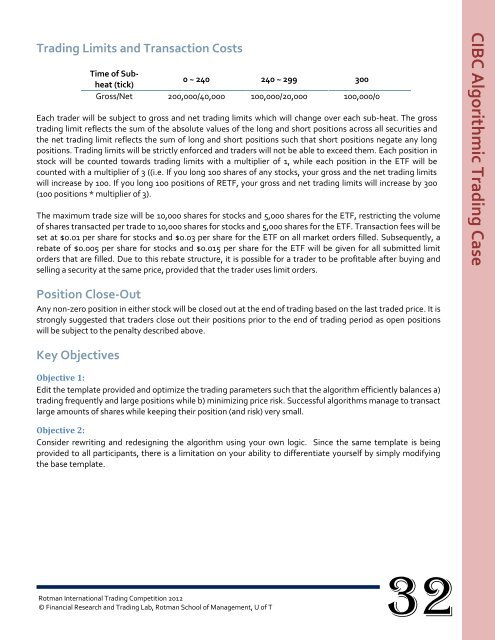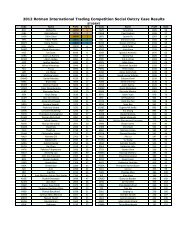RITC 2012 Case Package - Rotman International Trading ...
RITC 2012 Case Package - Rotman International Trading ...
RITC 2012 Case Package - Rotman International Trading ...
You also want an ePaper? Increase the reach of your titles
YUMPU automatically turns print PDFs into web optimized ePapers that Google loves.
<strong>Trading</strong> Limits and Transaction Costs<br />
Time of Subheat<br />
(tick)<br />
0 ~ 240 240 ~ 299 300<br />
Gross/Net 200,000/40,000 100,000/20,000 100,000/0<br />
Each trader will be subject to gross and net trading limits which will change over each sub-heat. The gross<br />
trading limit reflects the sum of the absolute values of the long and short positions across all securities and<br />
the net trading limit reflects the sum of long and short positions such that short positions negate any long<br />
positions. <strong>Trading</strong> limits will be strictly enforced and traders will not be able to exceed them. Each position in<br />
stock will be counted towards trading limits with a multiplier of 1, while each position in the ETF will be<br />
counted with a multiplier of 3 ((i.e. If you long 100 shares of any stocks, your gross and the net trading limits<br />
will increase by 100. If you long 100 positions of RETF, your gross and net trading limits will increase by 300<br />
(100 positions * multiplier of 3).<br />
The maximum trade size will be 10,000 shares for stocks and 5,000 shares for the ETF, restricting the volume<br />
of shares transacted per trade to 10,000 shares for stocks and 5,000 shares for the ETF. Transaction fees will be<br />
set at $0.01 per share for stocks and $0.03 per share for the ETF on all market orders filled. Subsequently, a<br />
rebate of $0.005 per share for stocks and $0.015 per share for the ETF will be given for all submitted limit<br />
orders that are filled. Due to this rebate structure, it is possible for a trader to be profitable after buying and<br />
selling a security at the same price, provided that the trader uses limit orders.<br />
Position Close-Out<br />
Any non-zero position in either stock will be closed out at the end of trading based on the last traded price. It is<br />
strongly suggested that traders close out their positions prior to the end of trading period as open positions<br />
will be subject to the penalty described above.<br />
Key Objectives<br />
Objective 1:<br />
Edit the template provided and optimize the trading parameters such that the algorithm efficiently balances a)<br />
trading frequently and large positions while b) minimizing price risk. Successful algorithms manage to transact<br />
large amounts of shares while keeping their position (and risk) very small.<br />
Objective 2:<br />
Consider rewriting and redesigning the algorithm using your own logic. Since the same template is being<br />
provided to all participants, there is a limitation on your ability to differentiate yourself by simply modifying<br />
the base template.<br />
<strong>Rotman</strong> <strong>International</strong> <strong>Trading</strong> Competition <strong>2012</strong><br />
© Financial Research and <strong>Trading</strong> Lab, <strong>Rotman</strong> School of Management, U of T<br />
32<br />
CIBC Algorithmic <strong>Trading</strong> <strong>Case</strong>



